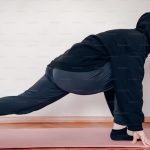The Sacroiliac Joint, commonly known as the SIJ, is a wondrous thing. We have two of them. They are the joints that connect our legs to our spine. They are incredibly stable but can also move in all directions. They house the shortest ligament in the body and they are a really common, but often overlooked, cause of back and leg pain. Here’s what every yogi needs to know about how to love your SIJ’s.
Anatomy
The SIJ is the joint between the large triangular bone at the base of the spine, called the sacrum, and the ilium on the back of the pelvic bones. The SIJ’s can be found under those cute dimples that some people have at the base of their back as it becomes the butt.
Nature has designed SIJ’s to be stable. The bone surfaces are covered with bumps and ridges which interlock to resist sliding in the joint. In the space between the joint surfaces is the Interosseous Ligament which is the strongest ligament in the body. Along with other really tough ligaments of the pelvis, the Interosseous Ligament holds the joint very firmly together.
Very stable joints tend to be the less mobile and this certainly applies to the SIJ. Though historically it was thought to not move at all, we now know that it moves a few millimetres any time we move our spine, put weight through our legs, or move our hips. These movements are a sort of nodding of the sacrum called nutation and counternutation. This involves rotation and sliding movements of the joint all at the same time. Though the total amount of movement is small it is very important and losing just a tiny bit of that movement can really cause problems – but more on that later.
Function
The SIJ’s transmit the weight of our trunk to the legs and vice versa. Any time we stand on one leg the Sacroiliac Ligaments go taut; the bumps of the joint surfaces lock into the grooves; and the muscles of the core and pelvis contract to give this amazingly stable connection. Maybe something to think about next time you are in Vrksasāna, or Tree Pose, because this is one time in yoga that the SIJ is working hard.
SIJ’s have a vital role in pregnancy and childbirth too. As a woman’s body prepares for birth it releases hormones that soften ligaments in the body. This allows the SIJ’s to move far more than their normal few millimetres during birth as the baby passes out of the mother’s pelvis. These hormones continue to be produced and the ligaments stay lax all the while the mother breastfeeds. They don’t return to normal and tighten up again until about 6 weeks after breastfeeding stops. This is partly why SIJ problems are far more common in women than men.
Common problems
- Not enough SIJ movement (Hypomobile) – the stiff joint struggles to cope with the forces going through it and can cause pain.
- Too much SIJ movement (Hypermobile) – the joint moves too much and the ligaments supporting the get overloaded and become painful. This is common in pregnancy and early motherhood due to those ligament softening hormones.
- Loss of muscular support – this can be due to a general lack of fitness or following injury or abdominal surgery. Without an effective muscular corset, the soft tissues around the joints get overloaded and can become painful.
How yoga can help
Some elements of yoga are HUGELY beneficial to problematic SIJ’s. Yoga develops strong abs, glutes and pelvic floor. These muscle groups are the ones that provide the muscular support for the SIJ’s. Result!
Many people with SIJ problems also have reduced range of movement in their spine and hips caused by tight soft tissues in the area. Yoga is a great way to gently ease into that tightness and increase movement. The combination of more movement and increasing muscular strength often reduces pain from a troublesome SIJ.
Mindfulness and meditation have been shown to help manage pain so these elements of our practice can also improve quality of life particularly for people suffering persistent pain from these joints.
Top tips for a happy SIJ
Unfortunately, SIJ’s are fickle beasts and other aspects of asāna can really flare them up.
In addition to generally modifying practice during pregnancy and breastfeeding, there are a few simple things we can all do to look after our loyal SIJ’s.
- Twists – protect your SIJ’s by always using your abs to twist and focus on pushing your pelvis forwards as well as your shoulder back. This means that the twist works up and down from your waist and reduces the load on your SIJ.
- Bandhas – taking care to engage mula and uddiyana bandhas helps to encourage mindfulness of muscular support to the SIJ’s during practice.
- Avoid pain – if something is painful don’t do it. Or modify it.
Your SIJ’s are truly amazing. Mindful yoga practice really can protect these incredible joints from future injury and will help them to recover if they are already painful. Invest in your SIJ’s and they will repay you in spades!












